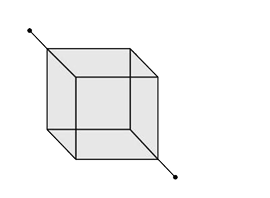Wires A and B have have identical lengths and have circular cross-sections. The radius of A is twice the radius of B i.e. RA=2RB. For a given temperature difference between the two ends, both wires conduct heat at the same rate. The relation between the thermal conductivities is given by-
KA=4KB
KA=2KB
KA=KB2
KA=KB4
The correct Answer is:D
To solve the problem, we need to analyze the heat conduction through the two wires A and B, given their dimensions and the relationship between their thermal conductivities.
1. Identify the Given Information:
- Wires A and B have identical lengths (L).
- The radius of wire A is twice that of wire B: RA=2RB.
- Both wires conduct heat at the same rate for a given temperature difference.
2. Understand the Heat Conduction Formula:
The rate of heat transfer (Q) through a wire is given by the formula:
Q=K⋅A⋅(T1−T2)⋅tL
where:
- K is the thermal conductivity,
- A is the cross-sectional area,
- T1−T2 is the temperature difference,
- t is the time,
- L is the length of the wire.
3. Calculate the Cross-Sectional Areas:
The cross-sectional area A of a circular wire is given by:
A=πR2
For wire A:
AA=πR2A=π(2RB)2=4πR2B
For wire B:
AB=πR2B
4. Set Up the Heat Transfer Equations:
Since both wires conduct heat at the same rate, we can set their heat transfer equations equal to each other:
KA⋅AA⋅(T1−T2)⋅tL=KB⋅AB⋅(T1−T2)⋅tL
The terms (T1−T2), t, and L cancel out:
KA⋅AA=KB⋅AB
5. Substitute the Areas:
Substitute the expressions for AA and AB:
KA⋅(4πR2B)=KB⋅(πR2B)
Cancel πR2B from both sides (assuming RB≠0):
4KA=KB
6. Rearrange to Find the Relation Between Conductivities:
Rearranging gives:
KA=KB4
Conclusion:
The relation between the thermal conductivities of wires A and B is:
KA=KB4
- Wires A and B have identical lengths (L).
- The radius of wire A is twice that of wire B: RA=2RB.
- Both wires conduct heat at the same rate for a given temperature difference.
The rate of heat transfer (Q) through a wire is given by the formula:
Q=K⋅A⋅(T1−T2)⋅tL
where:
- K is the thermal conductivity,
- A is the cross-sectional area,
- T1−T2 is the temperature difference,
- t is the time,
- L is the length of the wire.
The cross-sectional area A of a circular wire is given by:
A=πR2
For wire A:
AA=πR2A=π(2RB)2=4πR2B
For wire B:
AB=πR2B
Since both wires conduct heat at the same rate, we can set their heat transfer equations equal to each other:
KA⋅AA⋅(T1−T2)⋅tL=KB⋅AB⋅(T1−T2)⋅tL
The terms (T1−T2), t, and L cancel out:
KA⋅AA=KB⋅AB
Substitute the expressions for AA and AB:
KA⋅(4πR2B)=KB⋅(πR2B)
Cancel πR2B from both sides (assuming RB≠0):
4KA=KB
Rearranging gives:
KA=KB4
The relation between the thermal conductivities of wires A and B is:
KA=KB4
Topper's Solved these Questions
- CALORIMETRY AND HEAT TRANSFERBook:DC PANDEY ENGLISHChapter:CALORIMETRY AND HEAT TRANSFERExercise:Check points 16.4
Explore 29 Videos
- CALORIMETRY AND HEAT TRANSFERBook:DC PANDEY ENGLISHChapter:CALORIMETRY AND HEAT TRANSFERExercise:Taking it together
Explore 51 Videos
- CALORIMETRY AND HEAT TRANSFERBook:DC PANDEY ENGLISHChapter:CALORIMETRY AND HEAT TRANSFERExercise:Check point 16.2
Explore 10 Videos
- CALORIMETRY & HEAT TRANSFERBook:DC PANDEY ENGLISHChapter:CALORIMETRY & HEAT TRANSFERExercise:Level 2 Subjective
Explore 14 Videos
- CENTRE OF MASSBook:DC PANDEY ENGLISHChapter:CENTRE OF MASSExercise:Medical entrances gallery
Explore 27 Videos
Similar Questions
Knowledge Check
Two planets A and B have the same material density. If the radius of A is twice that of B, then the ratio of the escape velocity VA/VB is
A2B√2C1/√2D1/2
Two wires A and B have the same length and area of cross-secton. But Young's modulus of A is two times the Young's modulus of B. Then the ratio of force constant of A to that of B is
View SolutionTwo wires A and B have the same cross section and are made of the same material, but the length of wire A is twice that of B. Then, for a given load
View SolutionTwo uniform wires A and B are of the same total metal and have equal masses. The radius of wire A is twice that of wire B. The total resistance of A and B when connected in parallel is
View SolutionTwo rectangular blocks A and B of different metals have same length and same area of cross-section. They are kept in such a way that their cross-sectional area touch each other. The temperature at one end of A is 100∘C and B at the other end is 0∘C. If the ratio of their thermal conductivity is 1:3, then under steady state, the temperature of the junction in contact will be
View SolutionThe ratio of the areas of cross section of two rods of different materials is 1:2 and the ratio of ther themal conductivities of their mateirals is 4: 3. On keeping equal temperature difference between the ends of theserods, the rate of conduction of heat are equal. The ratio of the lengths of the rods is
View SolutionTwo cylindrical conductors A and B of same metallic material have their diameters in the ratio 1:2 and lengths in the ratio 2:1. If the temperature difference between their ends is same, the ratio of heats conducted respectively by A and B per second is,
View SolutionTwelve wires of equal length and same cross-section are connected in the form of a cube. If the resistance of each of the wires is R, and the effective resistance between the two diagonal ends is Re, then the ratio RRe is equal to __.

View Solution
